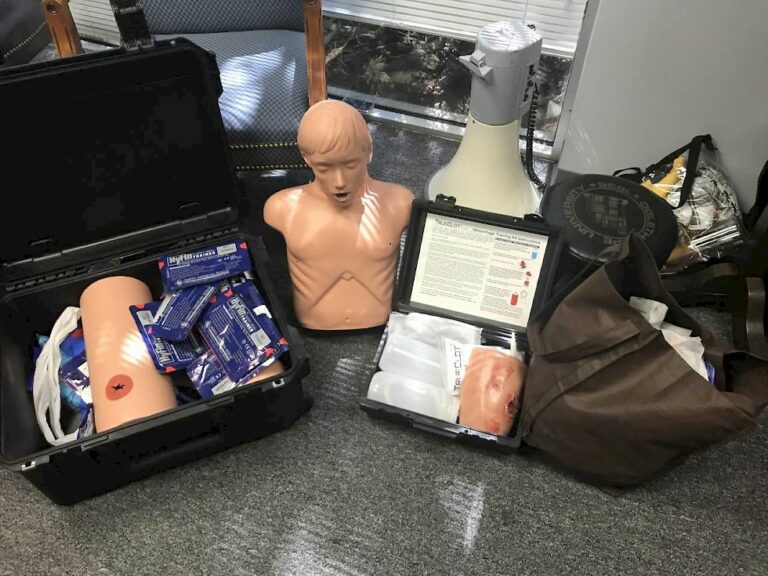
Article Archive by Year

When an injury causes a life-threatening bleed, minutes matter. There may not be enough time for first responders to arrive on the scene, so immediate responders are needed. Knowing how to respond to this type of injury and being able to stop the bleeding are skills that everyone should learn.

Suburban Fire Operations: Five Lessons Learned
May 11, 2022
From small fire companies covering large areas of rural land to large fire departments covering highly populated urban cities, suburban fire departments are tasked with a mixture of both. One firefighter who has spent his career in a suburban fire department shares the five key lessons he has learned throughout

Project Management Approach in Emergency Management
May 4, 2022
Emergency managers are project managers. While the intersection between the two professions is not often explicitly highlighted, navigating the phases of emergency management largely follows the project management framework. Therefore, a deeper understanding of project management best practices can only serve to enhance the ability to help communities and

Best Practice: Auxiliary Radios for Healthcare Facilities
April 27, 2022
When an emergency or disaster occurs, healthcare facilities require reliable communications for ensuring the safety and well-being of those in their care. The New York City Emergency Management Department has revamped its City’s emergency radio communications program to ensure that critical information can be exchanged before the next incident. Their

A Growing Threat to Healthcare and Other Facilities
April 20, 2022
Active shooter and other violent incidents occur all over the country – in urban and rural areas, in big cities and small towns, in large and small facilities. Many examples demonstrate the need to understand and plan for them and the significant consequences that could follow. This article empowers the

Securing & Protecting the Nation’s Cybersecurity Infrastructure
April 13, 2022
The Colonial Pipeline cyberattack in May 2021 exposed the urgent need to safeguard and upgrade the critical infrastructure systems in the United States. Congress acknowledged that the government lacks the authority to require private companies – which own, operate, and protect 85% of the nation’s critical energy infrastructure assets –

A Foot in the Door – The Value of Internships
April 6, 2022
Experience required. Many jobs require wide-ranging qualifications and expertise to be able to apply and interview. However, people often ask, “How can I get the experience if I cannot get a job?” A great way to get “a foot in the door” is through internships, which can be vital in

Disaster Procurement: Navigating the Supply Chain
March 30, 2022
There are moments during a disaster that something needs to be purchased. Depending on the nature of the purchase, it could be something small, perhaps something that can be purchased with a company credit card. On the other hand, it could be a purchase for millions of dollars and,

Radiation Emergency Medical Challenges and a Global Pandemic
March 23, 2022
It seems that every day over the past two years there are plenty of news stories covering the strain hospitals are facing in staffing shortages and the impacts from a global pandemic. Emergency medical services (EMS) are also dealing with their own similar issues across the nation. Many of these

PNT Signals as National Critical Infrastructure
March 16, 2022
Several national critical functions and all 16 critical infrastructure sectors rely either directly or indirectly on functional and consistent position, navigation, and timing (PNT) signals. As such, fragility of weak and easily imitated global positioning system (GPS) signals could lead to catastrophic impacts on dependent and interdependent critical infrastructure
Stop the Bleed Training for Immediate Responders
May 18, 2022
When an injury causes a life-threatening bleed, minutes matter. There may not be enough time for first responders to arrive on the scene, so immediate responders are needed. Knowing how to respond to this type of injury and being able to stop the bleeding are skills that everyone should learn.
Suburban Fire Operations: Five Lessons Learned
May 11, 2022
From small fire companies covering large areas of rural land to large fire departments covering highly populated urban cities, suburban fire departments are tasked with a mixture of both. One firefighter who has spent his career in a suburban fire department shares the five key lessons he has learned throughout
Project Management Approach in Emergency Management
May 4, 2022
Emergency managers are project managers. While the intersection between the two professions is not often explicitly highlighted, navigating the phases of emergency management largely follows the project management framework. Therefore, a deeper understanding of project management best practices can only serve to enhance the ability to help communities and
Best Practice: Auxiliary Radios for Healthcare Facilities
April 27, 2022
When an emergency or disaster occurs, healthcare facilities require reliable communications for ensuring the safety and well-being of those in their care. The New York City Emergency Management Department has revamped its City’s emergency radio communications program to ensure that critical information can be exchanged before the next incident. Their
A Growing Threat to Healthcare and Other Facilities
April 20, 2022
Active shooter and other violent incidents occur all over the country – in urban and rural areas, in big cities and small towns, in large and small facilities. Many examples demonstrate the need to understand and plan for them and the significant consequences that could follow. This article empowers the
Securing & Protecting the Nation’s Cybersecurity Infrastructure
April 13, 2022
The Colonial Pipeline cyberattack in May 2021 exposed the urgent need to safeguard and upgrade the critical infrastructure systems in the United States. Congress acknowledged that the government lacks the authority to require private companies – which own, operate, and protect 85% of the nation’s critical energy infrastructure assets –
A Foot in the Door – The Value of Internships
April 6, 2022
Experience required. Many jobs require wide-ranging qualifications and expertise to be able to apply and interview. However, people often ask, “How can I get the experience if I cannot get a job?” A great way to get “a foot in the door” is through internships, which can be vital in
Disaster Procurement: Navigating the Supply Chain
March 30, 2022
There are moments during a disaster that something needs to be purchased. Depending on the nature of the purchase, it could be something small, perhaps something that can be purchased with a company credit card. On the other hand, it could be a purchase for millions of dollars and,
Radiation Emergency Medical Challenges and a Global Pandemic
March 23, 2022
It seems that every day over the past two years there are plenty of news stories covering the strain hospitals are facing in staffing shortages and the impacts from a global pandemic. Emergency medical services (EMS) are also dealing with their own similar issues across the nation. Many of these
PNT Signals as National Critical Infrastructure
March 16, 2022
Several national critical functions and all 16 critical infrastructure sectors rely either directly or indirectly on functional and consistent position, navigation, and timing (PNT) signals. As such, fragility of weak and easily imitated global positioning system (GPS) signals could lead to catastrophic impacts on dependent and interdependent critical infrastructure
Follow Us
Get Instant Access
Subscribe today to Domestic Preparedness and get real-world insights for safer communities.
ARchives
Article Out Loud – Workplace Strategies to Reduce Burnout and Build Resilience
November 16, 2022
A multi-year pandemic has resulted in organizations looking to reframe traditional workforce management practices to retain seasoned staff and prevent burnout. To address these issues, state, local, tribal, and territorial emergency management offices can consider implementing workplace engagement strategies to address the mental and physical health concerns resulting from this
Article Out Loud – Switch to Online Enables New Active Shooter Training for All
November 16, 2022
Since the emergence of COVID-19, many trainings have had to adapt to an online presence. In one case, an active shooter training not only successfully transitioned to support the online delivery of these skills, but the developer embraced it and has now made it publicly available for everyone.
Article Out Loud – A Global Sensor Network for Disaster Warnings
November 15, 2022
Technology and sensor innovation must be interoperable across jurisdictions. Look how much global sensor networks for disaster warnings have evolved internationally since 2009.
Article Out Loud – National Preparedness: Challenges, Definitions & Jurisdictions
November 15, 2022
Change is often accompanied by challenges. This article shares the challenges that state and local jurisdictions faced in 2013 as they began implementing the guidance provided by Presidential Directive 8.
Article Out Loud – Power Outages, Communication Failures & Healthcare
November 9, 2022
After-action reviews highlight the successes and expose the failures of disaster preparedness and response efforts. Four significant events demonstrate how communities managed when power outages, communication failures, and healthcare concerns emerged in their aftermath.
Article Out Loud – The Role of Faith in Disasters
November 9, 2022
Many faith-based organizations have disaster response and recovery components as major elements of their own missions. By partnering with governmental and nongovernmental organizations, faith-based groups can coordinate locally to support response and restoration efforts, as well as provide mental health and spiritual care when resources are critically needed.
Article Out Loud – Integrating Law Enforcement & Emergency Management
November 8, 2022
When a tornado touches down, a school is under fire, or another disaster strikes, patrol officers often are the first response personnel at the scene. In addition to their traditional crime-fighting roles, patrol officers must be able to manage an incident until more support arrives, which requires additional training for
Article Out Loud – A Revised Definition of Homeland Security
November 8, 2022
A top-down approach provides guidance and support from federal agencies to local jurisdictions. A bottom-up approach ensures that local needs are being heard at the top. However, when local agencies are tasked with national security efforts, more guidance and support may be needed from above.
Article Out Loud – Training the Next Generation of Cyber Guardians
November 2, 2022
Despite small local governments being overrun with malware, ransomware, and myriad other threats, it is difficult to find experienced cybersecurity professionals. Meanwhile, students search for nonexistent entry-level jobs. One Washington State-based nonprofit is seeking to close this cybersecurity gap.
Article Out Loud – Nuclear Threats Against the Homeland: Impact and Preparation
November 2, 2022
How the war in Ukraine will end is unclear. However, research shows that there is the potential for devastating effects on a global scale. As such, it is important for emergency planners to reassess their all-hazards plans to ensure their communities identify the threats and ensure their planning processes include
Follow Us
Get Instant Access
Subscribe today to Domestic Preparedness and get real-world insights for safer communities.


